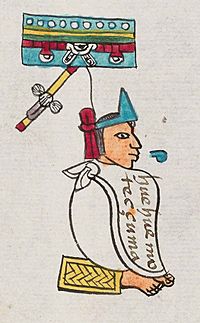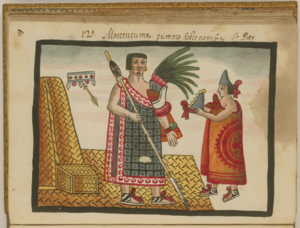Moctezuma I facts for kids
Quick facts for kids Moctezuma I |
|
|---|---|

Moctezuma I in the Codex Mendoza
|
|
| Tlatoani of Tenochtitlan | |
| Reign | 1440–1469 |
| Predecessor | Itzcoatl |
| Successor | Atotoztli II |
| Born | 1398 |
| Died | 1469 |
| Spouse | Queen Chichimecacihuatzin I |
| Issue | Princess Atotoztli II Princess Chichimecacihuatzin II Prince Iquehuacatzin Prince Mahchimaleh |
| Father | Emperor Huitzilihuitl |
| Mother | Queen Miahuaxihuitl |
Moctezuma I (born around 1398, died 1469) was a powerful Aztec leader. He was also known as Moteuczomatzin Ilhuicamina or Huehuemoteuczoma. He was the second Aztec emperor and the fifth king of Tenochtitlan, the capital city.
During his time as ruler, the Aztec Empire grew much stronger and larger. Tenochtitlan became the most important city in the Aztec Triple Alliance. Moctezuma I helped build the famous Aztec Empire that lasted until the Spanish arrived. He brought many changes to make the Aztec rule stronger.
Contents
Becoming the Emperor
Moctezuma became the ruler in 1440 when he was 42 years old. This happened after his uncle, Itzcoatl, passed away. Before that, Moctezuma and his brother Tlacaelel I were important generals in the Aztec army.
He was chosen by a group of important nobles. His title was "Great Speaker." This meant he spoke for both the Aztecs and the other groups they controlled.
His crowning was a very big event. Moctezuma sat on a special throne made of woven baskets. The ruler of Texcoco placed a turquoise crown on his head. This crown was known as the "fire crown."
Moctezuma's Time as Ruler
As the tlatoani (ruler), Moctezuma made his alliances stronger. He worked closely with two nearby states: Tlacopan and Texcoco. Tlacopan was a smaller city-state to the west. Texcoco was to the east.
These three cities formed the Aztec Triple Alliance. This alliance helped the Aztecs become very powerful. When they won battles, Tenochtitlan and Texcoco each got two-fifths of the treasures. Tlacopan received the remaining one-fifth.
One of the Aztecs' greatest achievements under Moctezuma was building a double aqueduct. He worked with Nezahualcoyotl of Texcoco on this project. This system brought fresh water to Tenochtitlan. It also supplied water to communities in Texcoco, stretching for 12 kilometers.
Early in his rule, Moctezuma led a conquest against the state of Oaxaca in 1445. He also expanded the Aztec Empire all the way to the Gulf of Mexico. This area was called the "Sea of the Sky." By conquering the Huastec people and Totonac peoples, the Aztecs gained access to valuable goods. These goods included cocoa, rubber, cotton, feathers, and seashells.
Facing Natural Disasters
Moctezuma was a strong leader who faced many natural challenges. In 1446, a huge swarm of locusts ate the crops. Then, in 1449, Lake Texcoco flooded the city of Tenochtitlan.
From 1450, the region suffered from frost and drought for four years. These natural disasters destroyed crops and caused widespread hunger. Many people had to sell their children or themselves into slavery to survive. The city lost many of its people during this difficult time.
The Flower War
After the famines, a series of conflicts began. These were known as the Flower War. The Triple Alliance fought against city-states like Huejotzingo, Tlaxcala, and Cholula.
The Aztecs believed the famines happened because their gods were angry. Moctezuma supported increasing human sacrifices to please the gods. The Flower War was fought to capture as many victims as possible for these sacrifices. This war continued until the Spanish arrived in Mexico.
Before a Flower War battle, Moctezuma would announce the war three times. He would even provide weapons to the enemy. If the enemy did not accept the last declaration, the Aztecs would attack within 20 days.
Expanding the Empire
Around 1458, Moctezuma led a military trip into Mixtec land. They attacked the city-state of Coixtlahuaca. The reason given was that Aztec merchants had been treated badly there.
Even though the Mixtecs had help from other groups, they were defeated. The Mixtec ruler, Atonal, was killed in a special ceremony. His family was taken as slaves. The Codex Mendoza, an ancient Aztec book, lists the tribute Coixtlahuaca had to pay. This included blankets, military outfits, feathers, dye, and gold dust. Moctezuma also led similar campaigns against other cities like Cosamaloapan and Ahuilizapan.
Social and Economic Changes
Even though Moctezuma led conquests, he kept peace within his empire from 1440 to 1453. This peace allowed his government to make important changes. These changes affected how people lived, how the government worked, and how the economy ran.
He created rules about what people of different classes could wear and how their houses could look. For example, only nobles or great warriors could have a house with a second story. No one was allowed to build towers, as Moctezuma believed only the gods could grant them.
He also made new rules for laws and education based on social class. In the palace, different classes had to be in different rooms. Mixing was not allowed and could even lead to severe punishment. Only Moctezuma himself could order a death sentence. All judges had to tell him about any death penalty decisions. Religion was also very important, and religious schools were required in every neighborhood.
His Family and What He Left Behind
After Moctezuma's death, his cousin or son Axayacatl became the next ruler. Moctezuma I is now a symbol of Mexican independence and strength.
He is not as well-known as his descendant, Moctezuma II, in popular culture. However, Moctezuma I appears in the Sid Meier's Civilization video game series. In these games, he leads the Aztec Empire. In Civilization VI, one of his special abilities gives more benefits from luxury resources and makes Aztec units stronger in battle. In the game, the Aztecs are known for being aggressive and expanding their territory. Moctezuma is also a playable character in the mobile game Rise of Kingdoms.
Some Native American tribes, especially the Tohono O'odham and Pueblo people, see Moctezuma as a "hero-god." His legend in their stories is a bit different from the real historical figure. But it shares parts of his story and likely came from tales about him. He is sometimes seen as a figure similar to Noah, who serves a higher power.
See also
- List of Tenochtitlan rulers
- List of people from Morelos, Mexico
- Oaxtepec
 In Spanish: Moctezuma Ilhuicamina para niños
In Spanish: Moctezuma Ilhuicamina para niños




